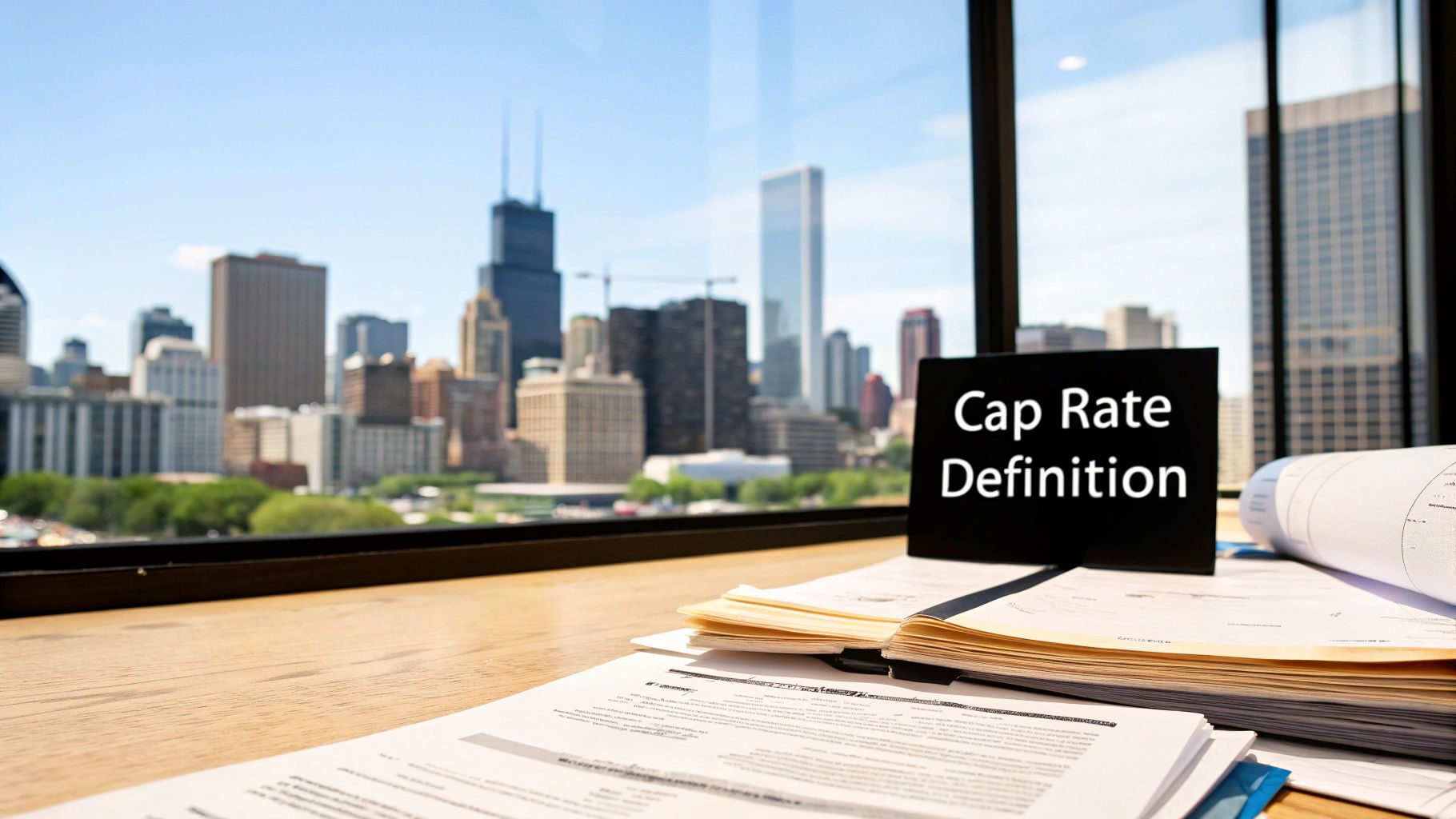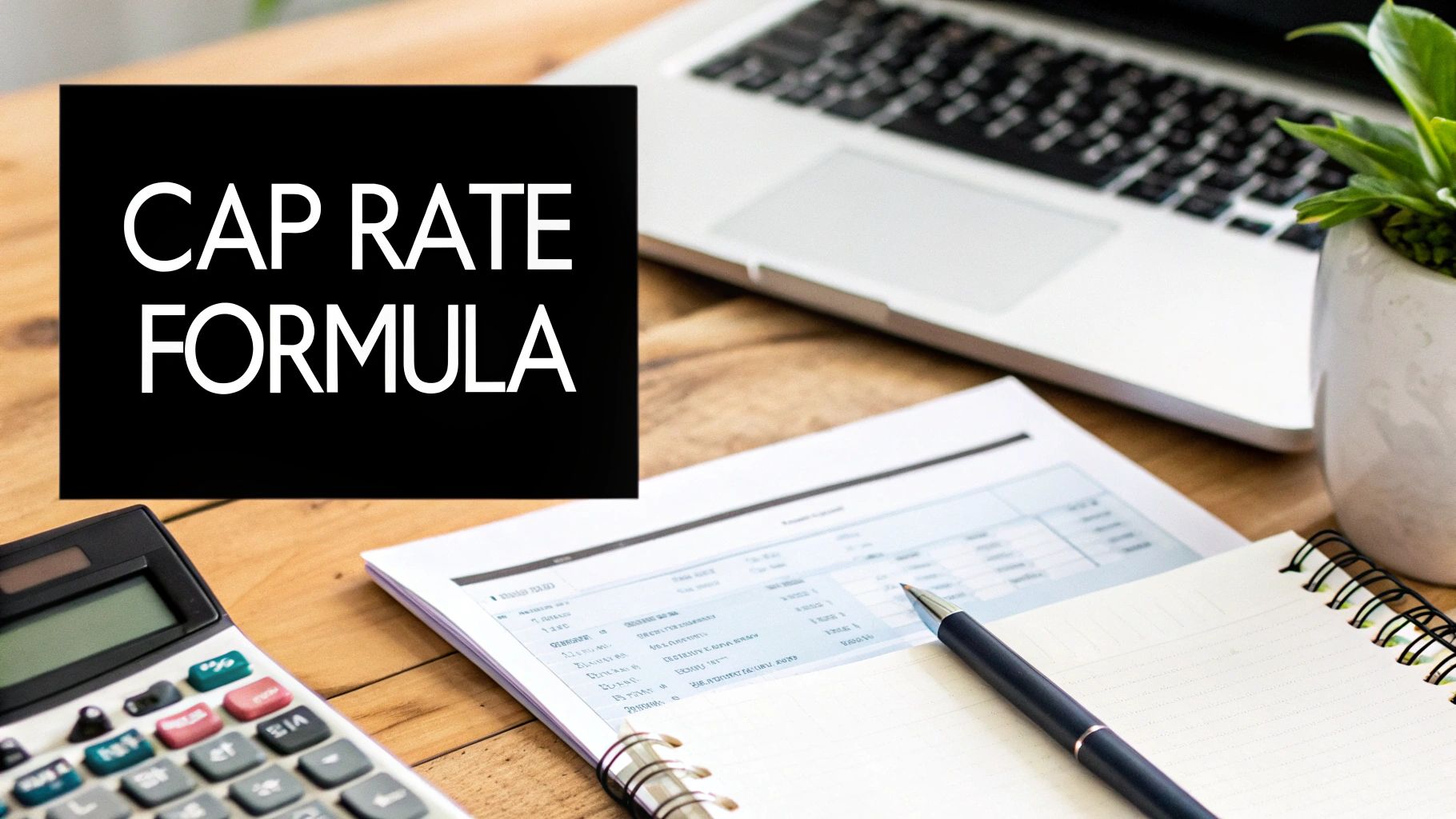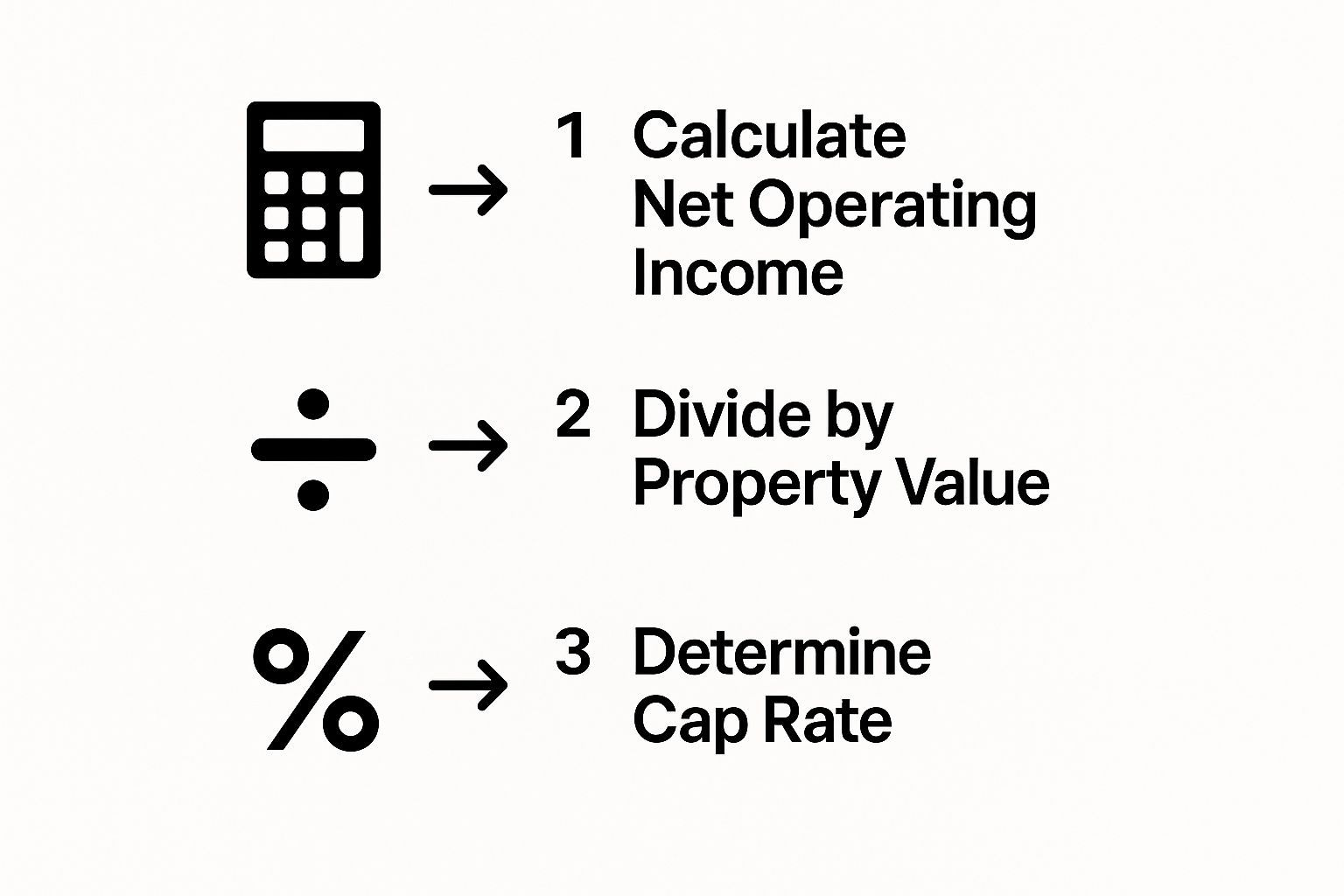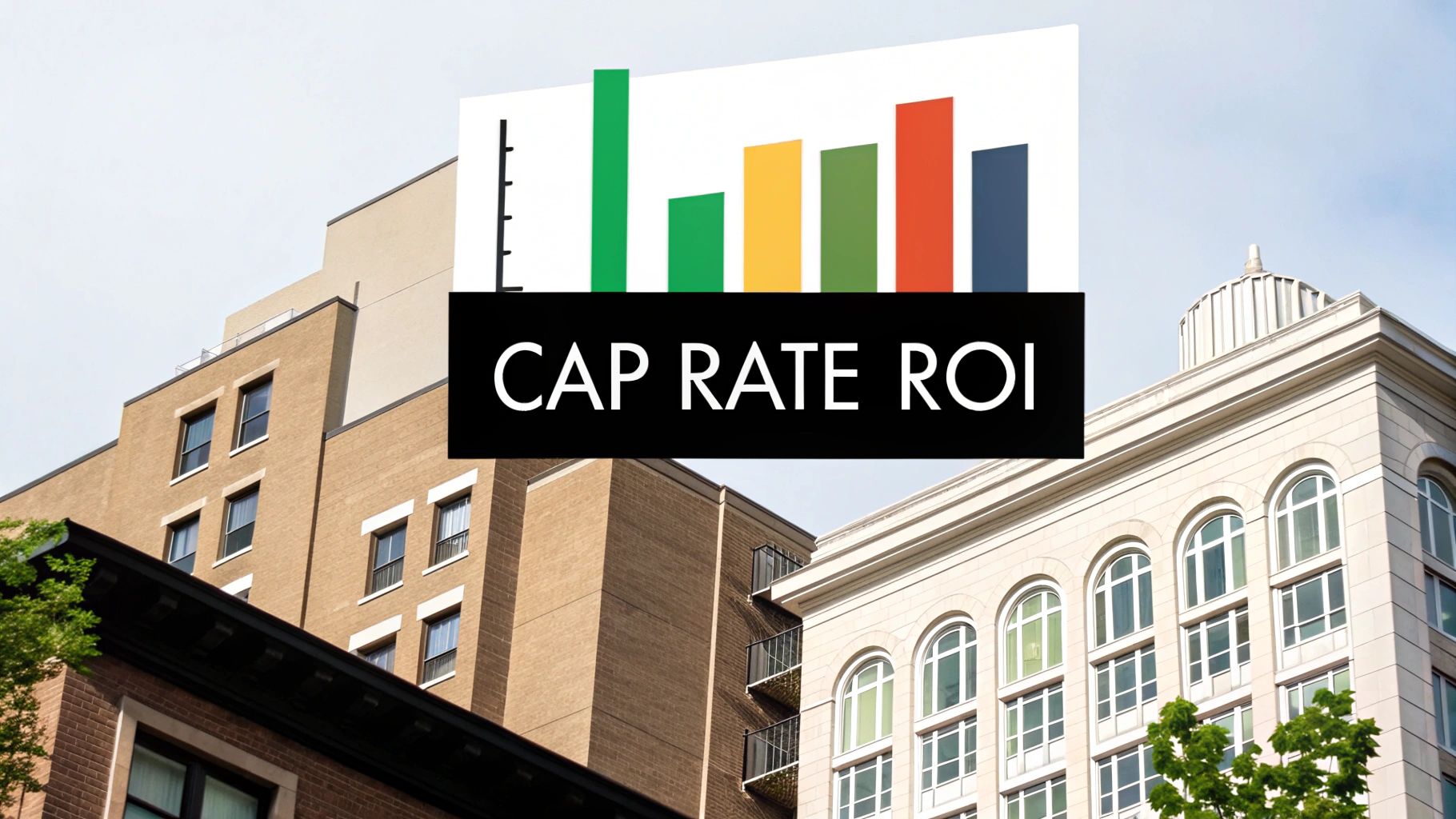What Is Cap Rate in Real Estate Investing?
- Sarah Porter

- Aug 27
- 11 min read
Updated: Aug 28
When you're looking at real estate deals, you need a quick way to size them up. That's where the capitalization rate, or cap rate, comes in. Think of it like a car's MPG rating—it's a simple, standardized number that lets you compare different investment properties at a glance.
A higher cap rate can signal a higher potential return, but it often comes with more risk. A lower cap rate might mean a safer, more stable investment, but with a more modest return.
What Is Cap Rate, Really?
At its core, the cap rate answers one crucial question: "If I bought this property with all cash, what would my annual return be?" It's a clean, straightforward look at a property's profitability, stripping away the complexities of loans and financing.
By focusing only on the property's income and its current market value, the cap rate gives you an apples-to-apples comparison tool. It cuts through the noise of different mortgage terms or down payment amounts, letting you see the raw earning potential of the asset itself.
This focus on fundamental performance is why seasoned investors rely on it so heavily. As a key metric in commercial real estate, the cap rate is the estimated return on an all-cash purchase. If you want to dive deeper into commercial real estate metrics, Dealpath offers some great insights.
To get a handle on cap rate, you first need to understand its two key ingredients:
Net Operating Income (NOI): This is your total income from the property (like rent) after you've paid all the necessary operating expenses (think property taxes, insurance, and routine maintenance).
Property Value: This is simply what the property is worth on the market today, or the price you're paying for it.

Cap Rate Formula at a Glance
The relationship between these two components is what gives you the cap rate. Let's break down the formula's inputs for a clearer picture.
Component | What It Represents | Why It Matters for Your Return |
|---|---|---|
Net Operating Income (NOI) | The property's annual profit before debt service and taxes. | This is the actual cash the property generates. A higher NOI means more potential profit. |
Property Value | The purchase price or current market value of the asset. | This is your initial investment. A lower price for the same NOI results in a better return. |
In short, the cap rate shows you how hard your capital is working for you, based entirely on the property's own performance.
How to Accurately Calculate Net Operating Income

Before you can even think about a property's cap rate, you have to get your hands dirty with its engine: the Net Operating Income (NOI). This number is the single most important measure of a property's day-to-day profitability, completely stripped of any financing or personal tax details. Getting this right is everything.
Think of NOI as what's left in the pot after all the property’s essential bills are paid for the year. To find it, you’ll start with all the money the property could make and then subtract all the money it costs to keep it running. This gives you a crystal-clear look at the asset's financial performance.
Starting with Gross Operating Income
First things first, let's figure out your Gross Operating Income (GOI). This isn't just a fantasy number of what you'd collect in a perfect world; it's the income you can realistically expect to hit your bank account.
You start with the Gross Potential Rent (GPR), which is the absolute maximum rent you could collect if every single unit was rented out for all 12 months. From there, you have to get real and subtract a budget for vacancies and tenants who don't pay. For example, if similar properties in the area have a 5% vacancy rate, you need to shave that off your GPR to get an honest starting point.
Key Takeaway: No property stays 100% occupied forever. Factoring in a realistic vacancy rate isn't pessimistic; it's smart investing. Base it on local market data or the building's own history for the most accurate projection.
Subtracting True Operating Expenses
With your realistic income figured out, it's time to deduct the operating expenses—all the costs necessary to keep the lights on and the tenants happy. These expenses generally fall into three buckets:
Fixed Expenses: These are the predictable bills you have to pay no matter what, like property taxes and insurance.
Variable Expenses: These costs can fluctuate depending on occupancy and usage. Think utilities, routine maintenance, and minor repairs.
Reserves: This is your "rainy day" fund. Experienced investors always set aside money each year for big-ticket items that will eventually need replacing, like a new roof in ten years or an HVAC system.
Knowing what not to include is just as critical. Things like your mortgage payment (principal and interest), income taxes, depreciation, and major capital improvements are left out of the NOI calculation. Why? Because the whole point of using cap rate is to compare properties on an apples-to-apples basis, independent of how someone chooses to finance or tax them. This approach isolates the property’s raw performance.
Putting the Cap Rate Formula into Practice
Now that we have a solid handle on Net Operating Income (NOI), let's plug it into the cap rate formula. Theory is great, but seeing how this simple calculation works with real-world examples is where its power as an investment tool really clicks.
The math itself is surprisingly simple. You're just taking the property's annual income and dividing it by its price.

This process directly compares a property’s raw profitability (NOI) against its current market value, giving you a clear percentage of its potential return. Let's walk through two different scenarios to see how this plays out.
Scenario 1: The Stable Downtown Condo
Let’s say you’re looking at a condo in a prime, well-established downtown neighborhood. The asking price is $500,000, and after running the numbers, you determine it has an annual NOI of $25,000.
Calculation: $25,000 (NOI) / $500,000 (Value) = 5.0% Cap Rate
A 5% cap rate might not sound thrilling, but it tells a story of stability. The location is excellent, vacancies are likely low, and property values are historically strong. Investors are willing to pay a premium for that kind of security, which in turn compresses (or lowers) the cap rate.
Scenario 2: The Up-and-Coming Duplex
Next, consider a duplex in a neighborhood that’s starting to gentrify. This property is priced at $300,000, but it generates the very same annual NOI of $25,000.
Calculation: $25,000 (NOI) / $300,000 (Value) = 8.3% Cap Rate
Key Insight: Notice that both properties produce the exact same income. The duplex’s higher cap rate signals a much better return relative to your initial investment. However, that higher return comes with higher risk—you might face more tenant turnover, deferred maintenance, or a less predictable local market.
These two examples show that cap rate is more than just a number; it’s a narrative about risk versus reward. A lower cap rate often points to safety and stability, while a higher cap rate suggests a greater potential for profit, but usually with more uncertainty attached.
So, you've calculated a cap rate. Now what? That percentage is more than just a number on a spreadsheet; it’s a quick snapshot of the market's opinion on a property. Learning to read that signal is what separates the pros from the rookies.
At its core, the most important thing to understand is the inverse relationship between cap rates and property values. Picture a seesaw: when the cap rate goes up, the property value goes down, and vice versa.
Low Cap Rates and High Value
Seeing a low cap rate, maybe around 4% or 5%, might not seem exciting at first, but it's telling you something important. It usually means the market views the property as a safe bet.
Low cap rates typically point to:
Lower Perceived Risk: The property is likely in a great neighborhood, has reliable tenants, and a solid track record.
Higher Property Value: Because the asset is seen as safe and desirable, more people want to buy it, which pushes the price up.
Future Appreciation Potential: These are often properties in up-and-coming areas where values are expected to climb.
Essentially, you're paying a premium for each dollar of income. In return, you get stability and the potential for long-term growth.
A lower cap rate is the market’s vote of confidence in a property's future. It suggests that investors anticipate consistent income and appreciation, making them willing to accept a smaller initial return on their cash investment.
High Cap Rates and High Returns
On the flip side, a higher cap rate—let's say 8% or more—paints a very different picture. These properties often have a lower price tag relative to the income they generate, which means more potential cash flow right out of the gate.
But there’s a catch. That higher return is your compensation for taking on more risk. Maybe the property is in a less desirable area, needs significant repairs, or has a shaky rent history.
So, what’s a “good” cap rate? It’s completely relative. It depends on the city, the type of property, and its condition. Across the board, commercial real estate cap rates can swing anywhere from 3% to 20%. Lower rates mean higher value and lower risk, while higher rates signal a lower price but potentially higher returns (and headaches). You can explore more about these commercial real estate trends to see how much they vary.
Ultimately, the right cap rate for you boils down to your personal investment strategy and how much risk you're comfortable with.
When to Use Cap Rate in Your Analysis

Knowing the cap rate formula is a great start, but the real skill lies in knowing when and how to apply it. Think of cap rate as your go-to tool for quick, back-of-the-napkin analysis. It's incredibly powerful for making swift comparisons.
Its biggest strength is that it levels the playing field between different properties, regardless of their price tags. By focusing purely on the property’s raw earning potential, the cap rate cuts through the noise of financing. It gives you the unlevered return—what you’d make if you bought the property with all cash. This is essential for a clean, unbiased first look.
This independent assessment is why cap rate remains a cornerstone for valuing commercial properties. Because it uses Net Operating Income (NOI), it provides a clear picture of profitability before any loans are factored in. You can dive deeper into this valuation method with some great insights over on TylerCauble.com.
A Tool for Comparison and Valuation
The real beauty of the cap rate is how versatile it is. Once you get the hang of it, you can use it in a few strategic ways to sharpen your investment decisions.
Comparing Multiple Properties: Got a list of ten potential deals? Cap rate lets you quickly sort them to see which ones offer the most bang for your buck, helping you focus your energy on the real contenders.
Assessing Market Trends: By watching how cap rates shift in a specific area, you can get a feel for the market's temperature. Are they going down? That means demand is up and prices are rising.
Validating an Asking Price: Cap rate is your reality check. You can quickly see if a seller’s asking price makes sense based on the income it generates and what similar properties are trading for.
Pro Tip: Flip the formula around to make it a negotiation tool. If you know properties in your target neighborhood typically trade at an 8% cap rate, and you find a building with an NOI of $40,000, you can work backward. Simply divide the NOI by your target cap rate ($40,000 / 0.08) to find that a fair offer would be around $500,000. This simple calculation helps you spot overpriced listings and make confident, data-driven offers.
Know the Limits: What Cap Rate Doesn't Tell You
Cap rate is a fantastic tool for a quick, back-of-the-napkin analysis. But you have to remember what it is: a snapshot. It’s a picture of a property's financial performance at one specific moment, based on a single year's income. It’s not the full-length feature film.
The biggest blind spot? Its static nature. The formula simply doesn't account for all the moving parts that determine your actual success over the long haul. Think about potential rent increases, a surprise roof replacement, or the powerful wealth-building effect of appreciation. None of that is in the equation.
The Big Things the Formula Skips
Because the cap rate looks at the property as if you paid all cash (an unlevered return), it gives you a clean but fundamentally incomplete picture. There are two huge pieces of the puzzle missing that could easily mislead you if this is the only number you look at.
Your Loan Doesn't Exist: The formula completely ignores financing. Since it assumes an all-cash deal, your mortgage payments are out of the picture. Your real-world return, what we call cash-on-cash return, will be drastically different once you subtract your loan costs.
The Future is a Blank: Cap rate offers zero insight into what might happen down the road. It can't predict changes in rental income, tell you when you'll need a new HVAC system, or factor in market shifts that could send your property value soaring (or sinking).
A cap rate is your starting point, not your final destination. It helps you quickly screen properties, but it should never be the only metric you use to make an investment decision.
Experienced investors get this. They use cap rate as one tool in a much larger analytical toolkit. While it gives you a glimpse of expected annual returns, it can't account for future NOI growth, capital expenses, or market appreciation.
That’s why you'll always see savvy investors pairing it with other metrics, like cash-on-cash return, to build a complete financial model. To get a better handle on this, you can dig deeper into these valuation strategies and see how they fit into a comprehensive investment plan by checking out more commercial real estate insights.
Answering Your Lingering Cap Rate Questions
Once you get the hang of the formula, the real questions start to pop up. How does this all play out in the real world when you're looking at actual deals? It’s one thing to understand the math, but it's another to know what it’s telling you.
Let's dive into some of the most common questions investors have when they start using cap rates.
Is a Higher Cap Rate Always a Better Deal?
Not always, and this is a classic rookie mistake. On paper, a higher cap rate looks like a home run because it suggests a better return. But it almost always comes with a catch: higher risk.
A high cap rate might signal that the property is in a rougher neighborhood, needs significant repairs, or struggles with tenant turnover. Think of it this way: the market is demanding a higher potential return to compensate for the headaches involved.
On the flip side, a lower cap rate usually means a more stable, lower-risk asset—the kind of property in a great location with solid tenants. The "better" investment really boils down to your own strategy and risk tolerance. Are you hunting for a high-yield project you can fix up, or do you prefer a steady, hands-off earner?
How Do Interest Rates Play into This?
Interest rates and cap rates tend to be dance partners; when one moves, the other often follows. When the Fed raises interest rates, getting a loan becomes more expensive. This cools down the market because fewer buyers can afford to jump in.
To keep deals moving, sellers might have to lower their asking prices.
So, what happens then? The property’s price goes down, but the income it generates (the NOI) stays the same. This forces the cap rate to go up. Conversely, when interest rates drop, borrowing is cheap, demand heats up, and property prices climb—pushing cap rates down.
Should I Bother with Cap Rate for a Single-Family Home?
You can calculate it, but honestly, it’s not the right tool for the job. Cap rate is the language of commercial real estate—think apartment buildings, office spaces, and strip malls, where the property's value is tied directly to its income stream.
For single-family homes, the valuation game is all about "comps," or what similar houses in the area have recently sold for. A much more practical metric for a single-family rental is Cash-on-Cash Return. It tells you the return on the actual money you pulled out of your pocket, which is often a more telling number when you're using a mortgage.
At Keshman Property Management, we get into the nitty-gritty of property valuation to help our clients make smart decisions and boost their returns. With over 20 years of hands-on experience, we know how to make owning rental properties a rewarding venture, not a stressful one. See how our transparent, owner-focused approach can make a difference for your portfolio by visiting us at https://mypropertymanaged.com.

Comments